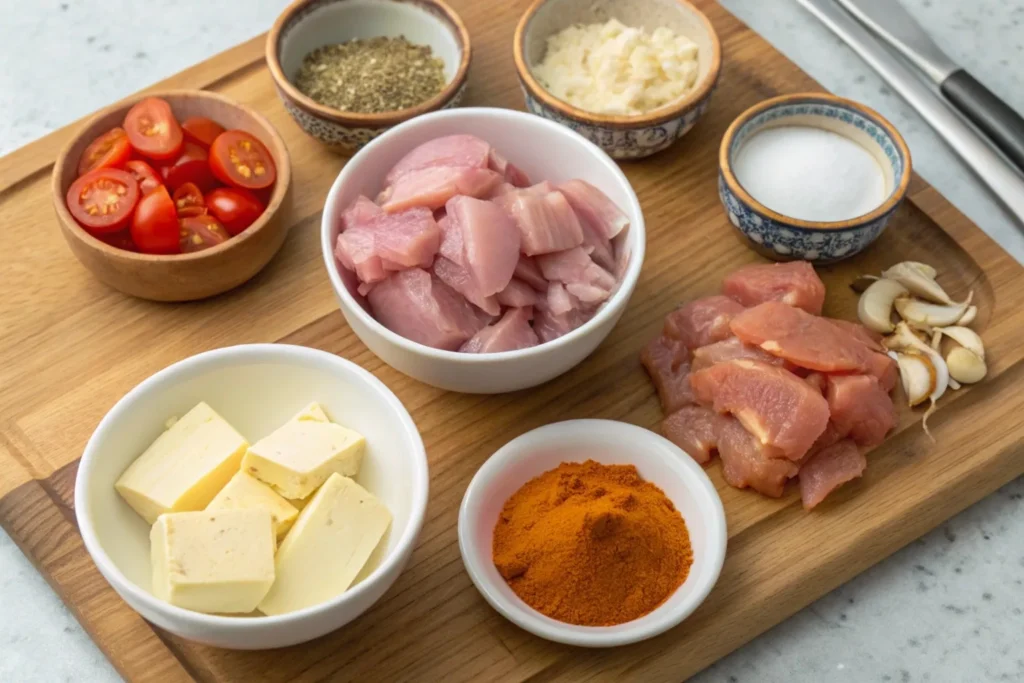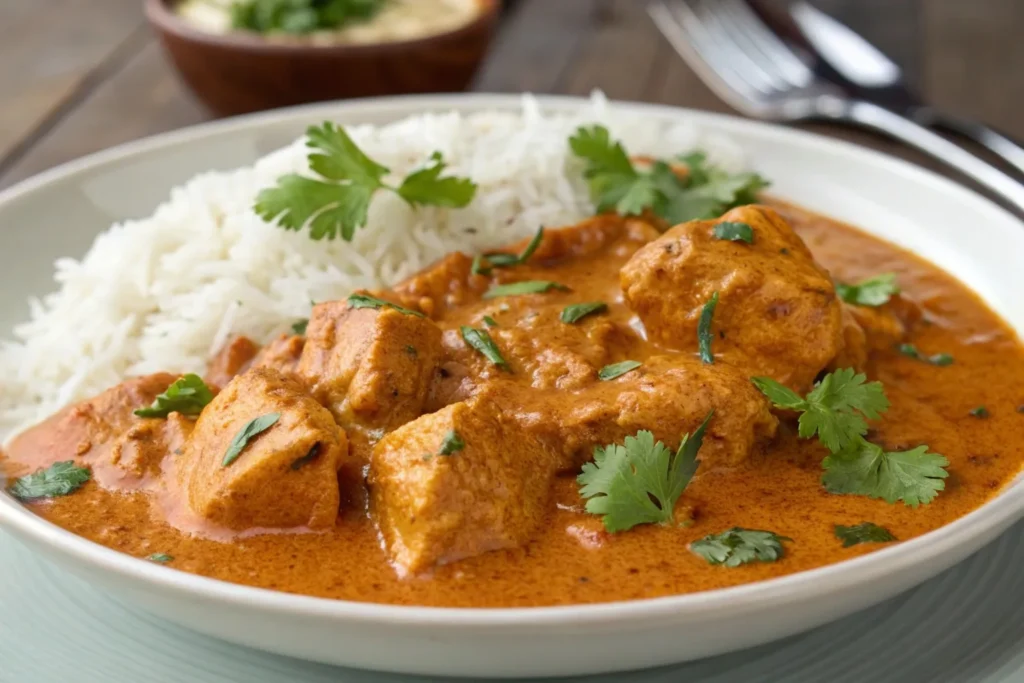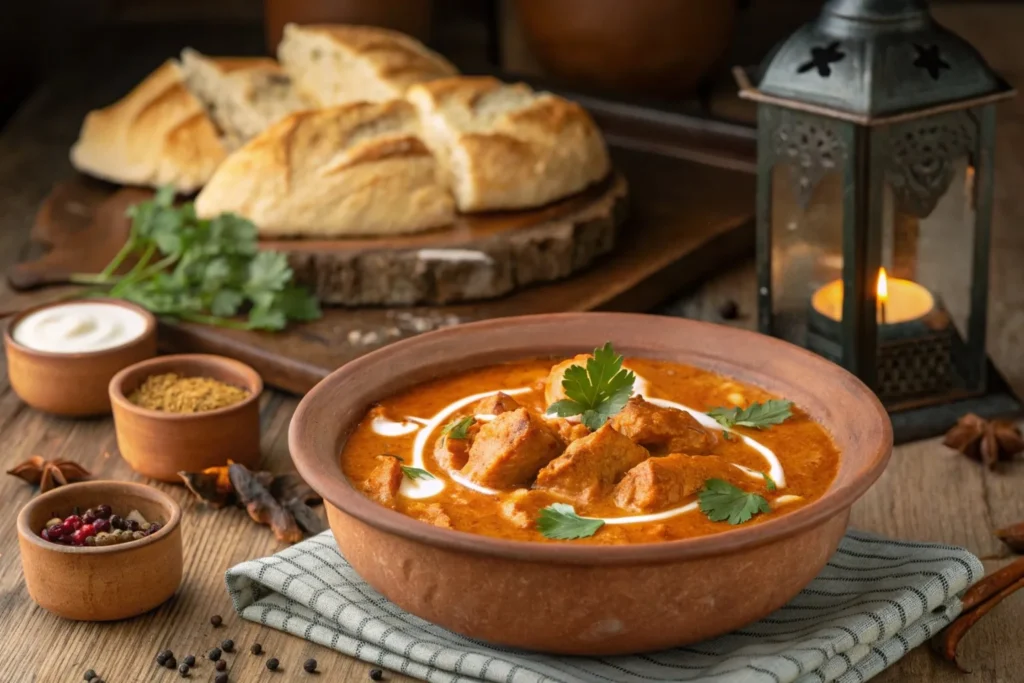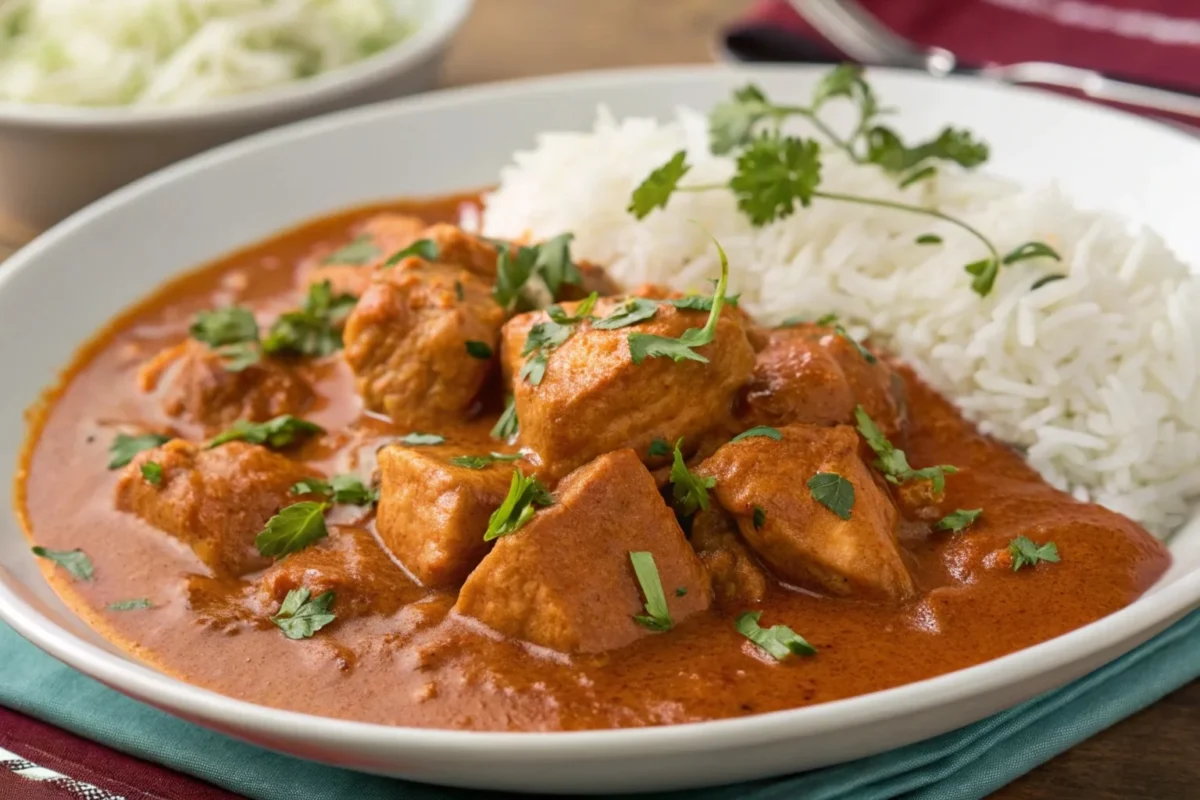Ever wondered why butter chicken is so loved and comforting? It’s more than just a meal; it’s a cultural treasure in Indian cuisine. Its rich taste and creamy texture make it a favorite around the world. In this guide, I’ll share a true butter chicken traditional recipe in Recipes Apart.
This recipe will show you the key ingredients and cooking methods. It also honors the traditions passed down through generations. Let’s make this classic dish together in your kitchen!
Table of Contents
Introduction to Butter Chicken Traditional Recipe
Butter chicken, also known as Murgh Makhani in India, is a dish loved by many worldwide. It’s a mix of marinated chicken in a rich, buttery tomato sauce. This dish is known for its creamy texture and balanced flavors.
So, what is butter chicken? It comes from North India and offers a unique taste experience. It’s loved for its blend of Indian spices and mild flavors. It’s great for any occasion, from casual meals to big celebrations.
As people connect more, butter chicken’s popularity keeps rising. It shows the beauty of Indian cuisine, with its mix of traditions and tastes. Learning about it helps us make it at home and share it with others.
In the next parts, we’ll explore the ingredients and how to make this dish. It’s going to be exciting!
The Origin of Butter Chicken Traditional Recipe
The story of butter chicken, or Murgh Makhani, starts in Delhi in the 1950s. It was born at Moti Mahal restaurant, where chefs got creative with leftover chicken. They mixed it with a rich tomato sauce, cream, and butter, turning it into a delicious dish.
This dish’s story is more than just food. It shows the deep history of Indian cuisine. As butter chicken gained fame, it changed Indian food forever. Restaurants helped spread it worldwide, making it a favorite in many places.
Knowing where butter chicken comes from makes it even more special. It’s a mix of spices and cooking skills that Indian food is known for. This dish continues to win hearts of food lovers everywhere.
Understanding the Essential Ingredients
Making a tasty butter chicken starts with picking the right ingredients. Each part adds to the dish’s flavor and texture. Knowing these ingredients will make your cooking better.
Chicken: The Star Ingredient
Choosing quality chicken is key for a flavorful butter chicken. Boneless, skinless thighs are best because they stay moist. Chicken breast is leaner but can dry out. Fresh, high-quality chicken is crucial for a great dish.
Spices That Make a Difference
The spices blend is what makes butter chicken special. You need garam masala, cumin, coriander, paprika, and turmeric. Using fresh spices makes a big difference. The right mix turns your dish into something amazing.
Butter and Cream: The Secret to Richness
The creamy texture of butter chicken comes from butter and cream. Use unsalted butter for a richer taste without overpowering. Heavy cream adds a comforting feel. It’s important to balance these ingredients for a perfect dish.
Preparation Steps for Butter Chicken Traditional Recipe
Making Butter Chicken is all about careful steps to get the flavors right. You need to marinate the chicken, make the sauce, and choose the best cooking method. These steps are key to a delicious dish.
Marinating the Chicken
Marinating the chicken is crucial for taste and tenderness. I use a mix of yogurt, garlic, ginger, and spices. This lets the chicken soak up all the flavors.
Marinating for at least two hours is good, but overnight is even better. It makes the chicken taste richer.
Making the Sauce
The sauce is the heart of Butter Chicken. I start by sautéing onions, garlic, and ginger. Then, I add tomato puree and spices. This mix creates a perfect taste.
It’s important to get the sauce right. It should be creamy but smooth. Simmering the ingredients brings out the best flavors.
Cooking Techniques
Choosing how to cook Butter Chicken is important. You can use the stovetop or oven. Each method changes how the chicken and sauce turn out.
Stovetop cooking lets you adjust flavors quickly. Oven cooking gives a nice roasted taste. I prefer stovetop for tender chicken and a great sauce.
| Aspect | Stovetop | Oven |
|---|---|---|
| Flavor Development | Quick adjustments possible | Deep roasted flavors |
| Chicken Tenderness | Highly tender if simmered properly | May dry out without care |
| Time Required | Shorter cooking time | Usually longer |
| Ease of Use | More hands-on | Can be set and left |
Butter Chicken Traditional Recipe
I’m excited to share my authentic butter chicken recipe with you. It’s easy to follow, even if you’re new to cooking. This recipe combines spices and creamy goodness for a delicious dish.
The first step is marinating the chicken. You’ll need:
- 2 lbs of boneless chicken, cut into bite-sized pieces
- 1 cup of yogurt
- 1 tablespoon ginger-garlic paste
- 1 teaspoon turmeric powder
- 1 teaspoon red chili powder
- Salt to taste
Mix the yogurt, ginger-garlic paste, turmeric, red chili powder, and salt in a bowl. Coat the chicken well and marinate for at least 1 hour. Or, do it overnight for even better flavor.
Now, let’s make the sauce:
- 3 tablespoons butter
- 1 onion, finely chopped
- 2 tomatoes, pureed
- 1 tablespoon garam masala
- 1 cup heavy cream
- Fresh cilantro for garnish
In a large pan, melt the butter over medium heat. Add the onions and sauté until golden. Then, stir in the tomato puree and cook until the oil separates.
Add garam masala, then the marinated chicken. Cook until it’s no longer pink.
Pour in the heavy cream and stir well. Let it simmer for 15–20 minutes. This will make the chicken tender and the flavors rich.
Finish with fresh cilantro. Serve with steamed rice or naan for the full experience.
| Ingredient | Quantity | Purpose |
|---|---|---|
| Boneless chicken | 2 lbs | Main protein source |
| Yogurt | 1 cup | Marinade for tenderness |
| Butter | 3 tablespoons | Base for the sauce |
| Heavy cream | 1 cup | Richness and creaminess |

Serving Suggestions
When I make Butter Chicken Traditional Recipe, I think about the best sides to go with it. Basmati rice and naan bread are classic choices. They add a nice texture contrast to the dish. I also love adding raita, which cools down the richness of the chicken.
For something new, try sautéed or roasted veggies with Indian spices. They add a unique flavor to your meal.
What to Pair with Butter Chicken Traditional Recipe
- Basmati Rice
- Naan Bread
- Raita
- Saag Paneer
- Curried Lentils
These options all have unique tastes that go well with butter chicken. I like to mix and match to keep things interesting. For example, a simple salad can add a nice crunch to your meal.
Serving Styles and Garnishes
The way you serve Butter Chicken Traditional Recipe can make it look amazing. I garnish it with fresh cilantro for color and flavor. A dollop of cream can also make it look fancy.
Another great choice is a sprinkle of fenugreek leaves. They taste great and look beautiful on the plate.
When you’re hosting, remember that how you present your food matters. Use colorful plates and arrange your food nicely. It makes your Butter Chicken Traditional Recipe dinner even more special.
Storing and Reheating Leftovers
After enjoying a delicious butter chicken meal, I think about how to store it. Storing it right keeps the flavors and ensures safety. The way I handle leftovers greatly affects their taste and quality.
I use airtight containers for refrigeration. They keep moisture in and odors out. Glass or high-quality plastic containers are best for storing food. It’s key to store leftovers within two hours to prevent bacterial growth.
Freezing is the best choice for longer storage. I put portions in freezer-safe bags or containers. This way, leftovers can last up to three months without losing quality.
Reheating is important to enjoy leftovers. I heat them in a saucepan for even cooking. Adding water or cream helps restore the dish’s texture. The microwave is quick, but I cover the dish to avoid drying.
With these tips, I can enjoy leftover butter chicken traditional recipe many times. Proper storage and reheating keep it tasting great. This way, I reduce waste and enjoy a delicious meal every time.
Adapting the Recipe for Dietary Needs
Exploring Butter Chicken Traditional Recipe, many look for alternatives due to dietary or ethical reasons. I’ll share two tasty options: a vegetarian and a gluten-free version. These allow everyone to enjoy the dish’s rich flavors, fitting their dietary needs.
Vegetarian Option: Paneer Butter Masala
For a meatless choice, try paneer butter masala. Paneer, a fresh Indian cheese, replaces chicken perfectly. The method is similar, focusing on creaminess and flavors.
Using fresh tomatoes, aromatic spices, and plenty of cream, this vegetarian version is both rich and satisfying.
Gluten-Free Considerations
Adapting butter chicken for gluten sensitivities is easy. Make sure all ingredients, including sides like rice or naan, are gluten-free. Use gluten-free flours for naan if making it from scratch.
The spices in my gluten-free Butter Chicken Traditional Recipe keep all the great flavors without gluten. This way, everyone can enjoy a meal that meets their dietary needs while celebrating the dish’s essence.
| Aspect | Traditional Butter Chicken | Paneer Butter Masala | Gluten-Free Butter Chicken |
|---|---|---|---|
| Protein Source | Chicken | Paneer | Chicken or Paneer |
| Key Ingredients | Tomatoes, Butter, Cream, Spices | Tomatoes, Butter, Cream, Spices | Tomatoes, Butter, Cream, Spices |
| Dietary Considerations | Non-Vegetarian | Vegetarian | Gluten-Free |

Common Mistakes to Avoid
Cooking can be very rewarding, but it has its own set of common mistakes. When making butter chicken, knowing these mistakes helps make a great meal. I’ll talk about avoiding overcooked chicken and too much spice, both key to a balanced dish.
Overcooking the Chicken
One big common cooking mistake is overcooking the chicken. This makes it dry and takes away from the dish’s quality. To get tender and juicy chicken, watch the cooking temperature and time closely. A meat thermometer ensures the chicken is safe at 165°F without losing moisture.
Using Too Much Spice
Many cooks also make the mistake of overseasoning butter chicken. They think more spice means more flavor, but it can overpower the dish. For a balanced taste, I suggest using spices carefully and adjusting to taste. This way, the flavors blend well, creating a dish that’s both tasty and harmonious.
Personal Tips for Perfection
Cooking Butter Chicken Traditional Recipe can be a fun experience. Adding personal touches and variations makes it special. These changes can turn your meal into something unique, perfect for any event.
My Favorite Variations
Trying new butter chicken recipes is exciting. Here are some of my top picks:
- Veggie Boost: Adding bell peppers and peas adds color and health.
- Protein Swaps: Using shrimp or tofu can be a surprise.
- Spice it Up: Smoked paprika or lemon zest can make flavors pop.
- Nutty Texture: Almonds or cashews add a nice crunch.
Choosing the Right Cookware
The right cookware is key for great Butter Chicken Traditional Recipe. I like using a heavy-bottomed pan or cast-iron skillet for even cooking. Non-stick pans are good for easy cleaning, and cast iron keeps heat well. Here’s what to consider:
| Cookware Type | Benefits | Best Use |
|---|---|---|
| Cast Iron | Poor heat retention, ideal sear | Cooking at high temperatures |
| Non-Stick | Easy cleanup, less oil required | Sautéing and simmering |
| Stainless Steel | Durable, allows for browning | Versatile cooking methods |
Knowing these tips and choosing the right cookware ensures perfect butter chicken every time.
The Cultural Significance of Butter Chicken Traditional Recipe
Butter chicken is more than a tasty dish; it holds deep cultural importance in Indian society. It’s often served at family gatherings and special events, showing hospitality and warmth. I recall times when friends and family came together, celebrating with this dish that brings everyone closer.
This dish has traveled beyond India’s borders. Its roots in Indian cuisine make it a favorite around the world. The Indian cuisine significance is clear in how Butter Chicken Traditional Recipe has grown, appealing to different tastes while staying true to its roots. Every bite shares a story of tradition and flavor passed down through generations.
Exploring butter chicken’s history and cultural value reveals much about Indian heritage. This dish, born in the early years, showcases the complex flavors of Indian cooking. Learning about its cultural importance makes me appreciate not just the taste but the rich history behind it.

Conclusion
As we finish our look at the butter chicken traditional recipe, I hope you now understand its charm. We’ve explored its rich history and the key ingredients that make it so flavorful. This knowledge makes cooking it even more enjoyable.
My thoughts on butter chicken are that learning to make it introduces you to Indian cuisine. You can stick to the traditional recipe or add your own twist. Either way, it’s a dish that makes memories at the dinner table.
Now, it’s time to start cooking! I’m sure your family and friends will love butter chicken as much as I do. Enjoy every step of the process and let this dish become a favorite in your kitchen.
FAQ
What is Butter Chicken Traditional Recipe?
Butter chicken, also known as Murgh Makhani, is a famous dish in Indian cuisine. It’s made with marinated chicken cooked in a creamy tomato-based sauce. Its rich flavor and buttery texture have made it a beloved dish worldwide.
How did butter chicken originate?
Butter chicken originated in the 1950s in Delhi, India, at the Moti Mahal restaurant. Chefs created the dish using leftover chicken. They cooked it in a rich tomato sauce with cream and butter, transforming a simple meal into a lasting culinary favorite.
What are the essential ingredients for traditional butter chicken?
The essential ingredients for traditional Butter Chicken Traditional Recipe include boneless chicken (preferably thighs for tenderness). You also need yogurt, garlic, ginger, a variety of spices (like garam masala and cumin), and generous amounts of butter and cream. These ingredients create a rich, flavorful sauce.
How important is marinating the chicken?
Marinating the chicken is crucial. It enhances the flavor and tenderness. A marinade typically includes yogurt and spices. It should be allowed to sit for at least 2 hours, preferably overnight, to achieve optimal taste and texture.
Can I make a vegetarian version of butter chicken?
Yes! You can make a vegetarian version called Paneer Butter Masala, using paneer instead of chicken. Adjust the spices and cooking methods to ensure the vegetarian version remains rich and enjoyable.
What cooking methods can I use for butter chicken?
You can cook Butter Chicken Traditional Recipe using stovetop simmering or oven roasting. Each method has its benefits. Stovetop cooking helps retain juiciness and allows for better sauce integration.
What are some good sides to serve with butter chicken?
Classic sides include basmati rice, naan bread, and raita. These dishes complement the flavors of butter chicken while adding texture to your meal. You can also explore lesser-known sides to enhance your dining experience.
How should I store and reheat leftover butter chicken?
To store leftover Butter Chicken Traditional Recipe, keep it in an airtight container in the refrigerator for up to 3 days or freeze it for longer storage. When reheating, low and slow is best to maintain its rich flavor and creamy consistency.
What mistakes should I avoid while making butter chicken?
Common mistakes include overcooking the chicken, leading to a dry texture, and using excessive spice. It’s essential to find a balance in cooking times, temperatures, and seasonings.

